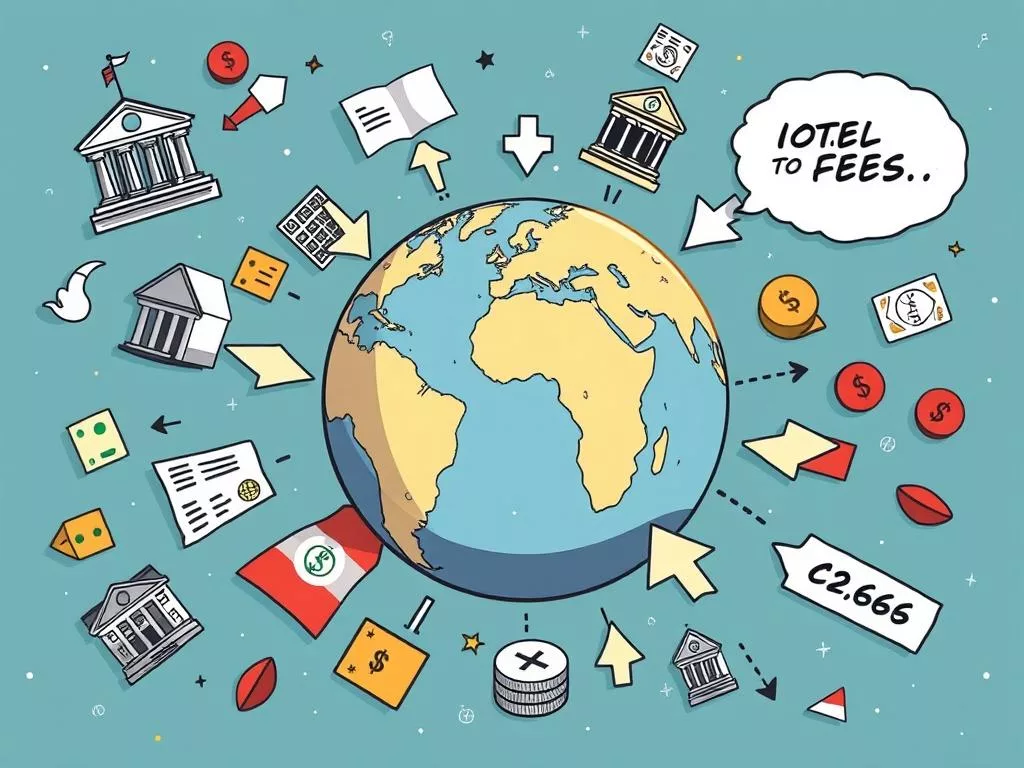Globalization has made international wire transfers more common. It’s important to know the fees involved. These fees can affect your money, whether for business or personal reasons.
Cross-border payments are expected to grow from $190 trillion in 2023 to $290 trillion by 2030. International wire transfers usually take one to five business days. This depends on the bank’s processing time and the accuracy of the recipient’s information.
In some cases, a transfer can reach the recipient in just one business day. But, delays are common due to checks and errors. Knowing the costs of international money transfers is key to handling these situations well.
Intermediary banks are important, often involving three to five banks in a SWIFT transfer. The time it takes depends on the banks’ relationship. For example, transfers between North America and Europe are faster than those between Europe and Africa.
Almost every bank offers international wire transfer services. The average fee for U.S. banks is $30 to $50 per transfer. Receiving banks may charge an extra $10 to $20. It’s important to understand these fees. Using resources like comparisons of different banks and services can help make better financial decisions.
What You Need to Know About Bank Fees for International Transfers
Bank fees for international transfers can change how much you send or get. The cost of wire transfers depends on the bank and if it’s domestic or international.
For domestic wire transfers, the median fee is $15 for incoming and $25 for outgoing. International transfers cost more. Incoming international wire transfers have a median fee of $15, while outgoing can be around $45.

Let’s look at some examples of international transfer fees from different banks. This helps us see how these fees can impact us:
| Bank | Incoming Domestic | Outgoing Domestic | Outgoing International |
|---|---|---|---|
| Bank of America | $15 | $30 | Varies by currency |
| Chase | $15 | $25 | $5 (foreign currency) / $40 (USD) |
| Ally Bank | $0 | $20 | Varies by currency |
| Wells Fargo | $15 | $25 | $25 (USD) |
Knowing these costs helps you pick the best bank and transfer method. For example, services like Wise and Xoom can be cheaper. Wise’s fee is about $6.42 per transfer, while Xoom charges a 5% fee plus a fixed currency fee. Wise transfers usually take two business days.
Different banks and services have different limits on how much you can transfer. Xoom lets you transfer up to $50,000 per day with extra verification. MoneyGram’s maximum is $10,000. It’s key to compare services to find what works best for you.
Guide to Bank Charges for Sending Money Abroad
When you send money overseas, knowing about bank charges is key. Banks can be very expensive, taking almost 13.40% of the money sent. The fees for international transfers from the U.S. can be around $45.
In Australia, banks charge a fee of 3% to 4% for converting currencies. They also have flat fees from AU$10 to AU$30. The exchange rate markup can be up to 5% more than the daily rate.
The table below shows the costs for different service providers:
| Provider | Flat Fees | Exchange Rate Markup |
|---|---|---|
| Wise | Typically less than 1% | Upfront fees |
| OFX | None | 1.35% to 4.50% |
| Xoom | As low as $0 | Over 3% |
| MoneyGram | Varies (AU$1) | Over 2% |
| Western Union | Under $5 | Extensive network |
Choosing the right provider is key to saving money. Wise has some of the best rates, charging less than 1%. OFX doesn’t charge transfer fees. MoneyGram and Western Union offer good rates, depending on the payment method and where you’re sending it.
Looking into bank wire fees and other costs can help you make better choices. For a detailed international transfer guide, consider using cheaper, faster, and more transparent alternatives.
Tips to Avoid High International Transfer Fees
It’s key to avoid high international transfer fees for good money management. Here are some tips to help you save on transfer fees and cut down on wire transfer costs:

- Compare Providers: Start by comparing different service providers for cheap international transfers. For example, traditional banks might charge up to $38 for outgoing international wire transfer fees. But, providers like BILL charge $0 when you pay in local currencies.
- Utilize Online Services: Online money transfer services like OFX offer great rates and low fees. OFX charges a flat fee of $15 for transfers under $10,000. And, there are no fees for amounts over $10,000, making it a smart choice.
- Avoid Intermediary Fees: It’s important to use services that cut down on intermediary charges. Banks can add up to a 7% margin on exchange rates. This can cost you up to an extra $500 on a $10,000 transfer. Choosing a provider that minimizes these fees can save you a lot.
- Explore Cheaper Options: Look into cheaper alternatives like blockchain payments and neobanks. They often avoid intermediary bank fees, saving you money on transfers.
- Negotiate Fees: If you send transfers often or deal with large amounts, try negotiating better terms or reduced fees with your bank. This can be a smart move.
Using these strategies can help you save on transfer fees and improve your financial planning. For more tips on saving money on transfers, check out our guide on the cheapest money exchange options and currency conversions.
Comparing Popular Banks’ International Transfer Fees
When you send money across borders, knowing the fees is key. Banks charge different amounts for international money transfers. For instance, Bank of America charges $15 for money coming in and $45 for going out in U.S. dollars. Chase fees range from $5 to $40, depending on the currency and method.
Wells Fargo has a varied fee system, with $15 for incoming wires and $0 to $40 for outgoing, based on the currency. US Bank charges more, with $25 for incoming and $50 for outgoing wires.
It’s also important to look at hidden costs like currency conversion fees. These can add up quickly. Also, consider using services like Wise, Remitly, and Xoom. They often have clear fees and good exchange rates. Knowing these details helps you save money when sending money abroad.

